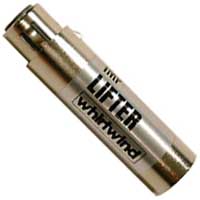So we have a worship center that is one of those large, gymnasium size rooms with multipurpose in mind. Sound booth is at the far end, opposite the stage and the amps are kept in a large storage room to SR. The amps are fed power from a junction box with 6 20A circuits, installed sometime after the original sound system was replaced for the current one. We use a tri-amp setup with two additional amps for four channels of monitors and two bridged mono amps for each side of the low end.
On stage there are several amps (bass, 2-3 guitars), two keyboards, etc. The bass amp is DI, the guitars have 57's in front of them. Keyboards are DI, no amps. Power wise- I assume these all are fed from the same transformer which probably feeds the HVAC as well as a giant walk-in freezer/fridge.
Now, I don't profess to understand the intricacies of building electrical design, nor fully understand how to tackle grounding issues (I doubt I'd be posting if I did), but we do have a bit of a ground hum throughout the system, primarily through the mains. It is not noticeable if we drive the preamps up on the individual channels and keep the master in the -10, -20 db range.
One very strange thing I've noticed is that we have a floor mounted TR terminal for one of our monitor outputs. There happens to be a 90 degree plug that runs from that output to the speaker. One day the side of the plug was contacting the faceplate on the terminal and lo and behold there was 60hz through that channel of monitors. Nothing was powered on at the moment.
The main reason I'm posting now is that a few parishioners who are in the band have been making noise about buying power conditioners for the equipment on stage. Every other piece of gear is behind a Furman on a sequencer except for the stage stuff. We've recently added some LED lighting and the power distribution is a mess currently, so I'm all for a couple of conditioners to at least divide what's going to lights vs. audio in some way. What I don't think this will do is solve our ground hum problem. I've heard a lot about what conditioners do, and Furman's own explanation leaves a bit to be desired. What is "noise" when referring to an AC line? Is it random oscillations in the sine wave? Does the conditioner smooth out the sine wave? If that's the case then it wouldn't do anything to affect the ground loop (not that I want to eliminate a ground from a power cable- because I don't).
What are your tricks and tips for eliminating mains hum?
On stage there are several amps (bass, 2-3 guitars), two keyboards, etc. The bass amp is DI, the guitars have 57's in front of them. Keyboards are DI, no amps. Power wise- I assume these all are fed from the same transformer which probably feeds the HVAC as well as a giant walk-in freezer/fridge.
Now, I don't profess to understand the intricacies of building electrical design, nor fully understand how to tackle grounding issues (I doubt I'd be posting if I did), but we do have a bit of a ground hum throughout the system, primarily through the mains. It is not noticeable if we drive the preamps up on the individual channels and keep the master in the -10, -20 db range.
One very strange thing I've noticed is that we have a floor mounted TR terminal for one of our monitor outputs. There happens to be a 90 degree plug that runs from that output to the speaker. One day the side of the plug was contacting the faceplate on the terminal and lo and behold there was 60hz through that channel of monitors. Nothing was powered on at the moment.
The main reason I'm posting now is that a few parishioners who are in the band have been making noise about buying power conditioners for the equipment on stage. Every other piece of gear is behind a Furman on a sequencer except for the stage stuff. We've recently added some LED lighting and the power distribution is a mess currently, so I'm all for a couple of conditioners to at least divide what's going to lights vs. audio in some way. What I don't think this will do is solve our ground hum problem. I've heard a lot about what conditioners do, and Furman's own explanation leaves a bit to be desired. What is "noise" when referring to an AC line? Is it random oscillations in the sine wave? Does the conditioner smooth out the sine wave? If that's the case then it wouldn't do anything to affect the ground loop (not that I want to eliminate a ground from a power cable- because I don't).
What are your tricks and tips for eliminating mains hum?



